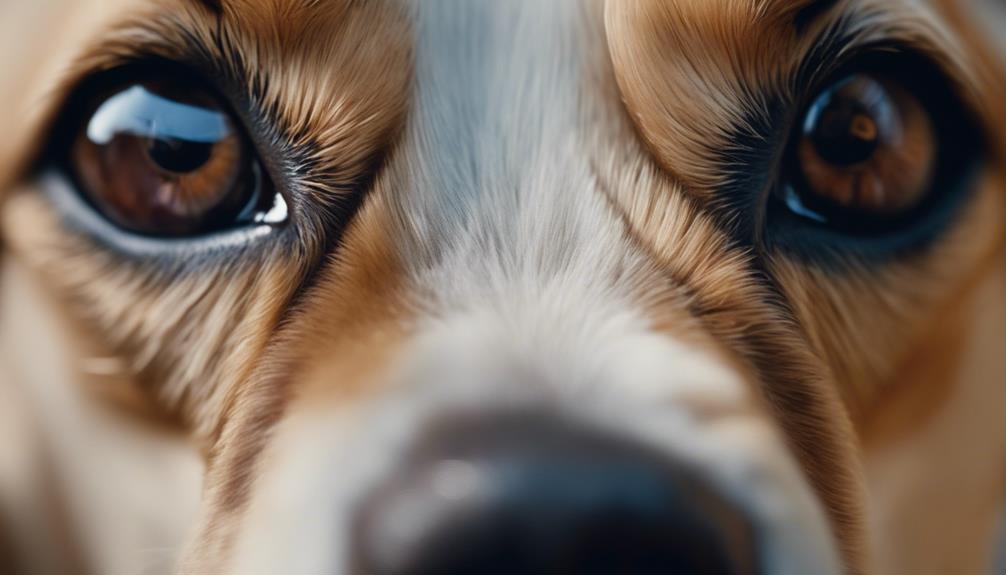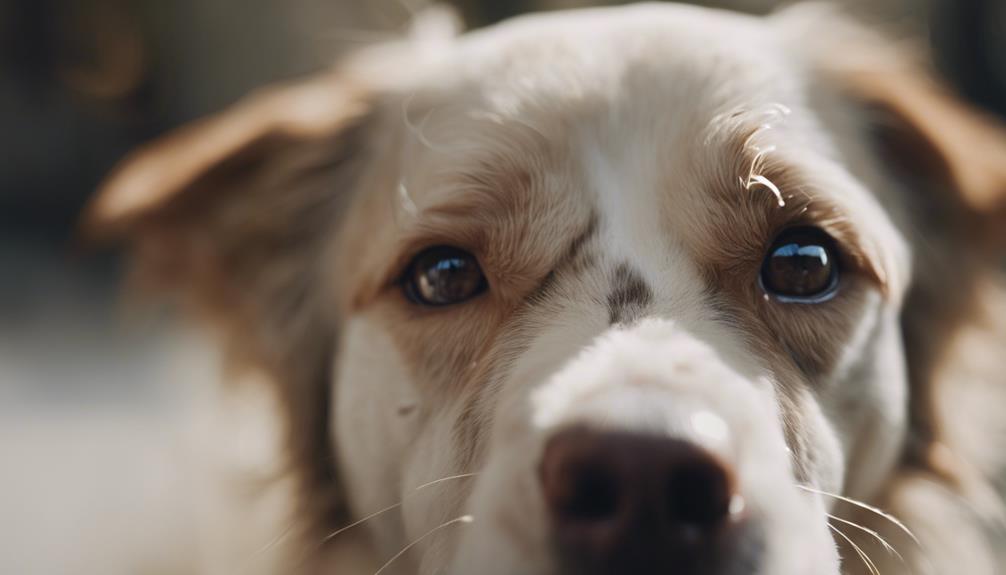In the realm of pet care, managing tear stains in dogs is a prevalent issue that many dog owners encounter. These unsightly marks beneath their eyes can be bothersome, but understanding the root causes and effective removal methods is crucial.
By exploring the intricacies of tear stains in canines, we aim to provide a comprehensive guide on how to eliminate them and prevent their recurrence.
Stay tuned to discover the practical tips and strategies that can help you bid farewell to those pesky tear stains and ensure your furry friend's eyes remain bright and healthy.
Key Takeaways
- Use ophthalmic wipes to clean tear stains.
- Keep fur around the eyes groomed and dry.
- Consult a vet for safe tear stain removers.
- Address underlying eye issues to prevent staining.
Understanding Tear Stains in Dogs
Tear stains in dogs, characterized by dark reddish or brown marks beneath their eyes, are commonly caused by tear overflow or poor drainage, often resulting in a cosmetic concern rather than a medical issue. These stains are a result of porphyrin deposits in tears, with the amount of porphyrin correlating with the color of the stain. While more visible on light-colored fur, tear stains can affect dogs of any color.
Certain breeds may have genetic issues affecting tear drainage, while brachycephalic breeds can experience tear overflow due to eye problems. Other potential causes include infections, glaucoma, stress, and allergies. Understanding the underlying reasons for tear stains is crucial in effectively managing and preventing their occurrence.
Causes of Tear Stains on Dogs
Understanding the factors contributing to the development of tear stains in dogs involves recognizing various causes beyond tear overflow or poor drainage. Porphyrin deposits in tears are a primary cause of tear stains, with the amount of porphyrin correlating with the color of the stains.
Genetic issues in certain breeds can hinder tear drainage, while eye problems in brachycephalic breeds may lead to tear overflow. Additionally, tear stains can be caused by infections, glaucoma, stress, and allergies.
Identifying these underlying causes is crucial in effectively addressing tear stains in dogs and implementing appropriate preventive measures to maintain eye health and hygiene.
How Tear Stains Develop

The development of tear stains in dogs is influenced by a combination of factors, including genetic predispositions and environmental triggers. Some breeds are more prone to tear staining due to genetic issues that affect tear drainage, leading to the accumulation of tears and subsequent staining. Environmental factors such as allergies, infections, and eye abnormalities can also contribute to the development of tear stains in dogs.
Additionally, the anatomy of certain breeds, like brachycephalic dogs, can cause tear overflow, exacerbating staining under the eyes. Understanding these factors can help dog owners better manage and prevent tear stains in their furry companions through appropriate grooming practices and veterinary care.
Factors Contributing to Tear Stains
Factors contributing to dog tear stains can vary from genetic predispositions to environmental influences, impacting the development of this cosmetic issue in canine companions. One key factor is the anatomy of the dog's face, which can affect tear drainage and lead to staining. Additionally, certain health conditions like eye infections or allergies can increase tear production and staining. Breed-specific characteristics, such as brachycephalic breeds with shallow eye sockets, may also be more prone to tear stains. Understanding these contributing factors can help pet owners take proactive steps to manage and prevent tear stains in their beloved dogs.
| Factors Contributing to Tear Stains | Examples |
|---|---|
| Genetics | Breed predispositions |
| Anatomy | Eye shape and tear ducts |
| Health Conditions | Infections, allergies |
| Environmental Influences | Pollution, irritants |
| Diet | Food sensitivities |
Identifying Tear Stains in Dogs

Upon observing dark reddish or brown marks under a dog's eyes, pet owners can easily identify tear stains in their canine companions. These stains are caused by the presence of porphyrin deposits in tears, which can be exacerbated by tear overflow or poor drainage.
While tear stains are more noticeable on light-colored fur, they can affect dogs of any color. It is important to differentiate tear stains from other eye-related issues such as infections or allergies, as tear stains are generally considered a cosmetic problem rather than a medical one.
Regular monitoring of tear stains and understanding their causes can help pet owners take appropriate steps to address and prevent them effectively.
Cleaning Tear Stains Safely
To effectively maintain the eye health of dogs and address tear stains, safe cleaning practices are essential. When cleaning tear stains on your dog, it is crucial to prioritize their safety and comfort. Opt for ophthalmic eye wipes or washes specifically formulated for dogs to clean deep fur stains gently.
Avoid using home remedies such as coconut oil near the eyes, as they may cause irritation or discomfort. Safe tear stain removers like wipes designed for this purpose are recommended. Additionally, a warm washcloth can be used to help loosen debris for easier removal.
Remember to consult your veterinarian before using any new cleaning products to ensure they are suitable for your dog's specific needs.
Choosing Tear Stain Removers

When considering ways to address tear stains in dogs, selecting the appropriate tear stain removers is crucial for effective and safe removal. Here are three key factors to consider when choosing tear stain removers:
- Ingredients: Opt for tear stain removers with gentle and natural ingredients to prevent irritation around the sensitive eye area.
- Formulation: Choose tear stain removers in the form of wipes or solutions that are specifically designed for use near the eyes for easier application and effectiveness.
- Veterinary Approval: Always consult with a veterinarian before using any tear stain remover to ensure it is suitable for your dog's individual needs and to avoid any potential complications.
Natural Tear Stain Removal Methods
Considering the importance of gentle and effective tear stain removal for dogs, exploring natural methods can offer a safe and holistic approach to addressing this cosmetic concern.
Natural tear stain removal methods include using a warm water and organic apple cider vinegar solution to gently wipe the stained areas.
Additionally, incorporating chamomile tea soaks can help reduce inflammation and lighten tear stains.
Another natural remedy is mixing cornstarch with hydrogen peroxide into a paste, applying it to the stained fur, and allowing it to dry before brushing it out.
These natural alternatives can be beneficial for pet owners looking to avoid harsh chemicals and are seeking a more organic approach to managing tear stains in their furry companions.
Preventing Tear Stains Naturally

Natural strategies can be implemented to prevent tear stains in dogs, promoting overall eye health and cleanliness. Here are three ways to naturally prevent tear stains in dogs:
- Dietary Adjustments: Providing a balanced diet with high-quality ingredients can help reduce tear staining. Opt for foods free from artificial additives and fillers, as these can contribute to tear production and staining.
- Regular Eye Cleaning: Gently wipe around your dog's eyes daily with a damp cloth to remove any build-up that could lead to tear stains. Keeping this area clean can help prevent staining from occurring.
- Proper Hydration: Ensure your dog has access to clean, fresh water at all times. Proper hydration can help maintain healthy tear production and prevent excessive tear staining.
Grooming Tips for Tear Stains
To effectively address tear stains in dogs, proper grooming practices play a crucial role in maintaining a clean and healthy appearance around their eyes. Regular grooming routines can help prevent tear stains from occurring and manage existing stains. Here are some grooming tips to help tackle tear stains:
| Grooming Tips for Tear Stains | |
|---|---|
| 1. Use ophthalmic eye wipes/washes for cleaning. | |
| 2. Avoid applying coconut oil near the eyes. | |
| 3. Opt for safe tear stain removers like specific wipes. | |
| 4. Gently use a warm washcloth to loosen debris. | |
| 5. Consult a vet before using any cleaning products. | |
Managing Tear Stains in Breeds

When addressing tear stains in different dog breeds, it is crucial to recognize that the management of these stains may vary based on specific breed characteristics and genetic predispositions.
Key Points:
- Brachycephalic Breeds: Breeds with short noses like Bulldogs or Pugs may have tear stains due to their facial structure causing tear overflow.
- Light-Colored Breeds: Dogs with white or light-colored fur, such as Maltese or Bichon Frise, may show tear stains more prominently.
- Breeds Prone to Eye Issues: Certain breeds like Shih Tzus or Cocker Spaniels are predisposed to eye problems affecting tear drainage, leading to stains.
Professional Help for Tear Stains
Professional intervention for managing tear stains in dogs involves specialized treatments and procedures tailored to address underlying causes effectively. Veterinarians may recommend tear duct flushing to clear blockages or surgical correction for structural abnormalities hindering proper tear drainage.
In cases where tear stains result from allergies or infections, targeted medications or dietary changes could be prescribed to alleviate the root issue. Additionally, professional grooming services may offer specialized tear stain removal techniques using safe and vet-approved products.
Regular follow-ups with a vet are crucial to monitor progress and adjust treatment plans as needed. Seeking professional help ensures a comprehensive approach to managing tear stains, promoting your dog's eye health and overall well-being.
Related Pet Health Articles

One key aspect of maintaining your pet's health is staying informed about various pet health articles. These articles can provide valuable insights into common health issues, preventive measures, and treatment options for your furry companion. Here are three reasons why staying updated on related pet health articles is essential:
- Early Detection: Pet health articles often highlight early signs and symptoms of various health conditions, allowing pet owners to detect potential issues promptly.
- Preventive Care: By reading pet health articles, pet owners can learn about preventive care measures such as vaccinations, regular check-ups, and proper nutrition to keep their pets healthy.
- Treatment Options: Understanding different treatment options discussed in pet health articles can help pet owners make informed decisions regarding their pet's healthcare.
Conclusion
In conclusion, addressing tear stains in dogs requires an understanding of the underlying causes, effective cleaning methods, and preventive strategies.
By implementing proper grooming techniques and seeking professional help when necessary, pet owners can proactively manage tear stains and promote their dog's ocular health.
With the knowledge and tools outlined in this guide, pet owners can ensure a happier, healthier life for their canine companions.




